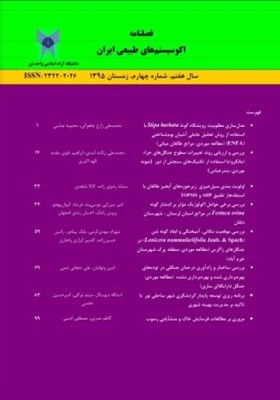مدلسازی مطلوبیت رویشگاه گونة Stipa barbata با استفاده از روش تحلیل عاملی آشیان بومشناختی (ENFA) (مطالعه موردی: مراتع طالقان میانی)
محورهای موضوعی : جنگلداریمحمدعلی زارع چاهوکی 1 * , محبوبه عباسی 2
1 - دانشگاه تهران
2 - دانشگاه تهران
کلید واژه:
چکیده مقاله :
این پژوهش بهمنظور تعیین مطلوبیت رویشگاه گونة S. barbata با استفاده از روش تحلیل عاملی آشیان بومشناختی در مراتع طالقان میانی انجام شده است. گونة S. barbata از گندمیان مرغوب و با ارزش مرتعی است که اهمیت زیادی در حفاظت خاک و تولید علوفه دامها دارد. بهمنظور مدلسازی مطلوبیت رویشگاه این گونه، از نقاط حضور گونه و لایههای اطلاعاتی متغیرهای خاکی از جمله درصد سنگریزه، اسیدیته، هدایت الکتریکی، درصد آهک، مادةآلی، نیتروژن، پتاسیم، فسفر، عمق خاک، درصد شن، رس و سیلت و نقشه متغیرهای توپوگرافی منطقه (شیب، جهت و ارتفاع) بهعنوان متغیرهای مؤثر بر حضور گونه استفاده شد. صحت مدل با استفاده از شاخص بویس مقدار 5/87% بهدست آمد که نشاندهنده دقت بالای نتایج مدل است و ضریب کاپای بهدست آمده از بررسی میزان تطابق نقشة پیشبینی با واقعیت زمینی نیز (64/0k=) بهدست آمد. نتایج حاصل از بررسیها نشان میدهد که در انتخاب رویشگاه گونه S. barbata در منطقه مورد مطالعه متغیرهای محیطی ارتفاع، جهت شمالی، هدایت الکتریکی و پتاسیم تأثیر منفی و متغیرهای عمق، آهک، مادهآلی و اسیدیته تأثیر مثبت داشتهاند و مهمترین عوامل در مطلوبیت رویشگاه این گونه بودهاند. با توجه به مقادیر حاشیهگرایی (64/1)، تخصص-گرایی (399/8) و تحملپذیری کل (119/0) بهدست آمده از مدل، میتوان نتیجه گرفت که گونه مورد مطالعه نسبت به شرایط خاصی از متغیرهای محیطی تخصص پیدا کرده است و دامنه خاصی از متغیرهای محیطی را در محدوده منطقه مورد مطالعه تحمل میکند.
This study was done aimed to determine the habitat suitability of S. barbata species using ecological niche factor analysis in rangeland of Taleghan miany. Stipa barbata species has good quality and the preference value that is important in soil conservation and forage production for livestock. In order to habitat suitability modeling for this species were used than presence point and the soil variables such as the information layers of gravel, pH, lime, organic matter, N, K, P, sand, clay, silt and topographic variables maps (slope, aspect and Height) were used as variables affecting the species. The results of the study indicate that in the habitat suitability of S. barbata species in the study area environment variables height, direction of North, EC has a negative impact and depth, lime, organic matter and pH variables has a positive impact, And have been important factors. Accuracy model is calculated 87/5% using continue Boyce index that to verify the accuracy of the model results. Kappa coefficient obtained by matching the prediction map with ground truth equal 0.76. According to the results obtained values marginality (1.64), specialization (8.39) and toleranc of (0.119) obtained from the model, it can be concluded that the S. barbata species is specialty relative to the specific conditions of the environment variables, and tolerate the specific domain of environmental variables in the range the study area.

